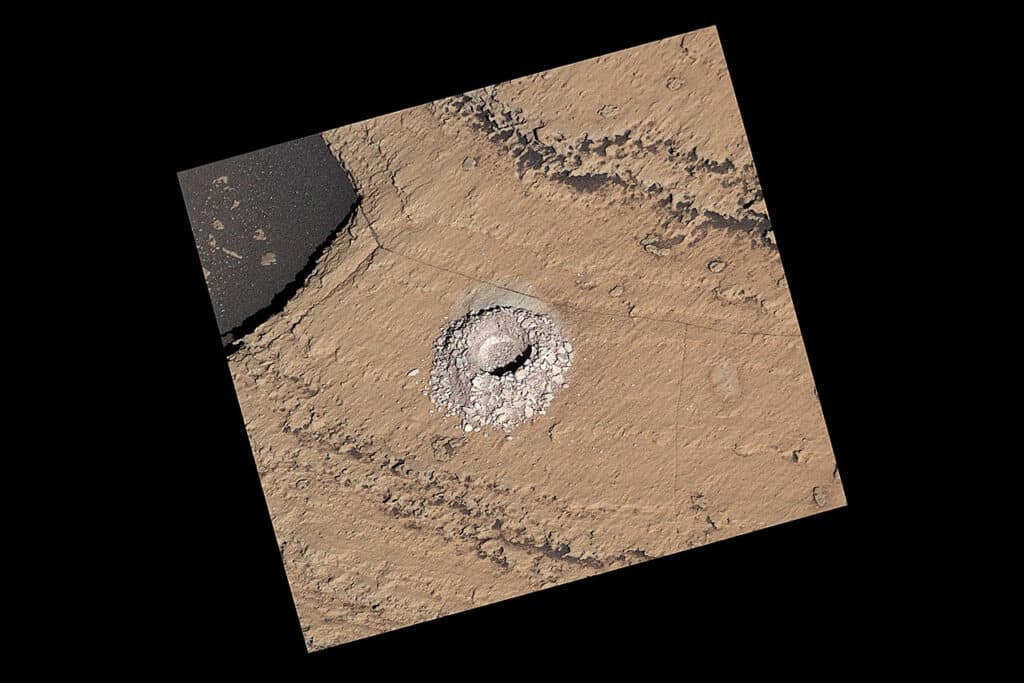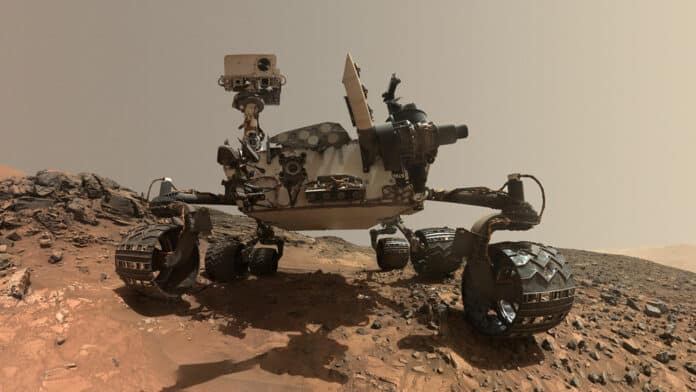NASA’s Curiosity Mars rover has achieved a remarkable milestone by completing 4,000 “sols,” or Red Planet days, since landing on the Red Planet back in 2012. Considering the difficult Martian environment, Curiosity is still in good shape and continues to perform exciting science experiments, even after such a long time.
The rover recently drilled its 39th sample and then dropped the pulverized rock into its onboard laboratory for detailed analysis. Scientists say the newly drilled sample may add to its flood of evidence.
As a key part of NASA’s search for life on Mars, the rover has been collecting evidence of minerals, rocks, and other parts of the environment shaped by water. The rover’s goal is to study whether ancient Mars had the conditions to support microbial life.
For this, the rover has been gradually ascending the base of 3-mile-tall (5-kilometer-tall) Mount Sharp. The layers of the mountain were formed in different periods of Martian history and offer a record of how the planet’s climate changed over time.
The most recent sample came from a target nicknamed “Sequoia,” which could shed light on how the climate and habitability of Mars evolved as this region became enriched in sulfates. Those minerals are likely formed in salty water evaporating as Mars first began drying up billions of years ago. This discovery is a significant step towards understanding how Mars’ liquid water disappeared for good.

“The types of sulfate and carbonate minerals that Curiosity’s instruments have identified in the last year help us understand what Mars was like so long ago. We’ve been anticipating these results for decades, and now Sequoia will tell us even more,” said Ashwin Vasavada, Curiosity’s project scientist at NASA’s Jet Propulsion Laboratory.
Scientists are trying to understand the ancient climate of Mars by studying its minerals. In their recent work, they used data from Curiosity’s Chemistry and Mineralogy (CheMin) instrument to discover a magnesium sulfate mineral called starkeyite. This mineral is associated with especially dry climates like Mars’ modern climate.
The team believes that the sulfate minerals were originally formed in salty water that evaporated billions of years ago, and then these minerals transformed into starkeyite as the climate continued drying to its present state. This finding helps scientists to better understand how Mars evolved into its present state.
Curiosity has endured a harsh journey of nearly 20 miles (32 kilometers) across a punishingly cold environment bathed in dust and radiation since 2012, but it still remains strong.

However, the rover is facing a minor issue with a camera on Mastcam, considered one of its main “eyes” of Curiosity, and engineers are currently working to resolve them. Each of Mastcam’s two cameras provides color images of the rover’s surroundings and helps scientists determine the composition of rocks by analyzing the wavelengths of light or spectra they reflect in different colors.
To perform this analysis, Mastcam uses filters on a wheel that rotates under each camera’s lens, but since September 19th, the left camera’s filter wheel has been frozen between positions. This has affected the quality of the mission’s raw or unprocessed images, but NASA engineers are trying to slot it back in place.
“If unable to nudge it back all the way, the mission would rely on the higher-resolution 100 mm focal length right Mastcam as the primary color-imaging system,” reads a NASA blog. “As a result, how the team scouts for science targets and rover routes would be affected: The right camera needs to take nine times more images than the left to cover the same area. The teams also would have a degraded ability to observe the detailed color spectra of rocks from afar.”
Along with efforts to nudge the filter back, mission engineers are closely monitoring the rover’s nuclear power source. In the longer term, Curiosity’s nuclear power source continues to dwindle, but the team stresses that the rover still has enough energy to operate for many more years.
In addition, repeated use, dust, and wind are also slowly wearing down the rover’s drill system and robotic arm joints. But software updates have fixed bugs and added new capabilities to Curiosity, too, making long drives easier for the rover and reducing wheel wear that comes from steering.
Meanwhile, the team is preparing for a break of several weeks in November. It will freeze communications with the rover during solar conjunction when Mars flies behind the sun from the perspective of Earth.
Plasma from the Sun can interact with radio waves, potentially interfering with commands during this time, so the agency always stops sending commands to its Mars robots at this time. Engineers are leaving Curiosity with a to-do list for these next few weeks, after which period communications can safely resume.
